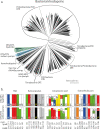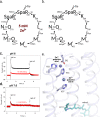Mirror proteorhodopsins
- PMID: 37130895
- PMCID: PMC10154332
- DOI: 10.1038/s42004-023-00884-8
Mirror proteorhodopsins
Abstract
Proteorhodopsins (PRs), bacterial light-driven outward proton pumps comprise the first discovered and largest family of rhodopsins, they play a significant role in life on the Earth. A big remaining mystery was that up-to-date there was no described bacterial rhodopsins pumping protons at acidic pH despite the fact that bacteria live in different pH environment. Here we describe conceptually new bacterial rhodopsins which are operating as outward proton pumps at acidic pH. A comprehensive function-structure study of a representative of a new clade of proton pumping rhodopsins which we name "mirror proteorhodopsins", from Sphingomonas paucimobilis (SpaR) shows cavity/gate architecture of the proton translocation pathway rather resembling channelrhodopsins than the known rhodopsin proton pumps. Another unique property of mirror proteorhodopsins is that proton pumping is inhibited by a millimolar concentration of zinc. We also show that mirror proteorhodopsins are extensively represented in opportunistic multidrug resistant human pathogens, plant growth-promoting and zinc solubilizing bacteria. They may be of optogenetic interest.
© 2023. The Author(s).
Conflict of interest statement
The authors declare no competing interests.
Figures






References
Grants and funding
LinkOut - more resources
Full Text Sources

